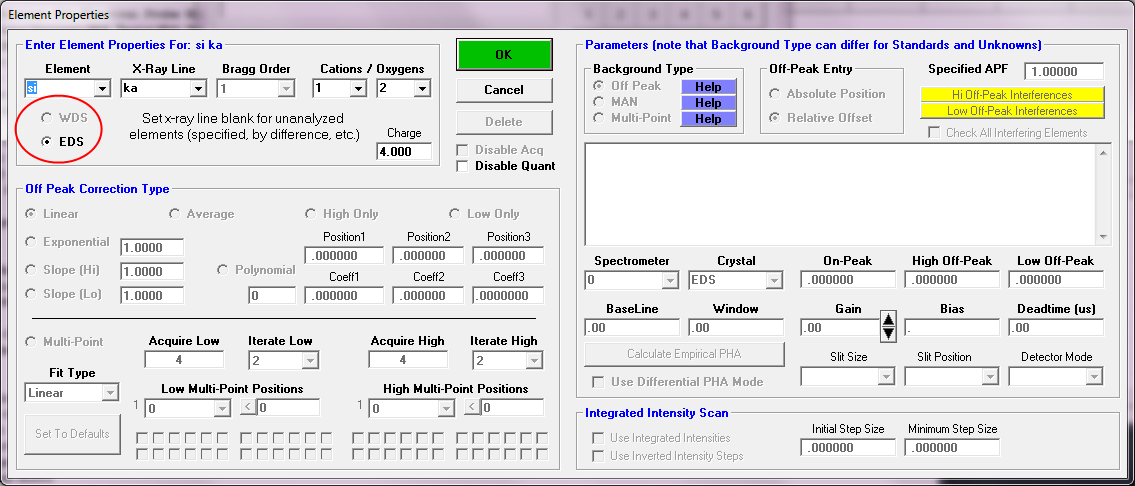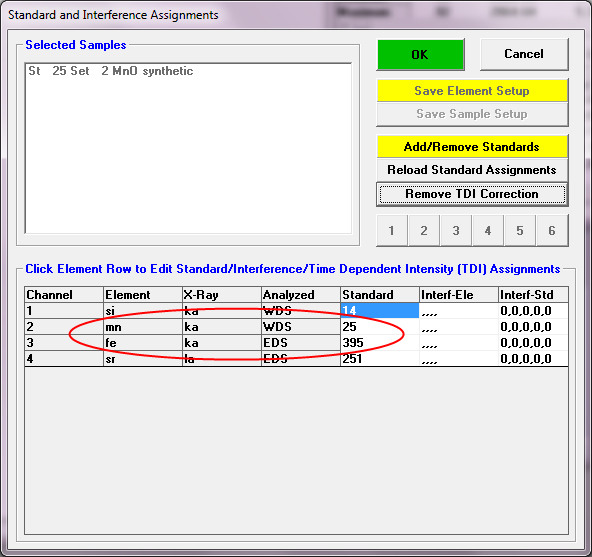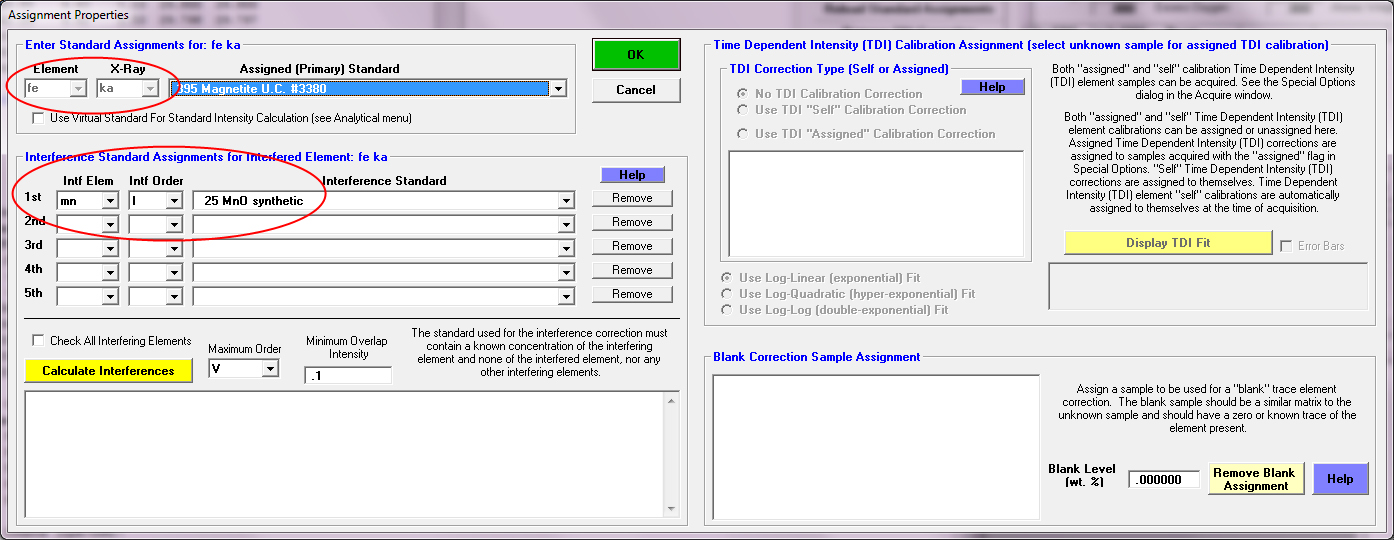Thank-you David Steel and Julie Chouinard for this suggestion!
The latest version of Probe for EPMA now fully integrates WDS and EDS elements into a single array so that all analytical calculations can be performed on all elements regardless of their detector origin- with some exceptions (e.g., no TDI correction for EDS yet!).
However, the interference correction as requested by David and Julie can now be applied across all elements, whether EDS or WDS. This is possible because the quantitative interference correction in PFE is based on concentration as opposed to intensity. So, because one can acquire their WDS elements along with a full EDS spectrum for every analysis, one can make fully quantitative interference corrections in PFE using elements by EDS added in off-line (or on-line) processing of data as seen here:

Note that the EDS elements can be changed or added post acquisition since we have a full EDS spectrum for every analysis!
Here is an example, Fe ka interfered by Mn. In this example I acquired Fe on the EDS spectrometer and Mn on the WDS spectrometer to make the interference a worst case situation as seen here:
St 25 Set 2 MnO synthetic
TakeOff = 40.0 KiloVolt = 15.0 Beam Current = 30.0 Beam Size = 0
(Magnification (analytical) = 40000), Beam Mode = Analog Spot
(Magnification (default) = 400, Magnification (imaging) = 800)
Image Shift (X,Y): .00, .00
Specimen from Michael Wittenauer (Purdue Univ.)
Starting mat'l 99.999%, SM # 317, 'skull melt' process
Mat. Res. Bull. 15, p 571, 1980
(possible intergrowths of Mn3O4 and small inclusions of Mn metal)
EPMA (UCB): SiO2=0.00, FeO=0.00, CaO=0.00, Al2O3=0
Number of Data Lines: 5 Number of 'Good' Data Lines: 5
First/Last Date-Time: 04/27/2015 12:17:14 PM to 04/27/2015 12:24:58 PM
Stage (or Beam Deflection) Coordinate Positions:
X Y Z X Y Z
131G 16350.00 -5011.000 -36.00000 132G 16354.00 -5011.000 -36.00000
133G 16358.00 -5011.000 -36.00000 134G 16362.00 -5011.000 -36.00000
135G 16366.00 -5011.000 -36.00000
Sample Coordinates Referenced to Fiducial Set 1 C:\UserData\StandardPOSData\alkali-glass_pos4.pos
On and Off Peak Positions:
ELEM: si ka mn ka fe ka sr la
ONPEAK 27889.0 23811.0 .000000 .000000
OFFSET -148.43 228.352 .000000 .000000
HIPEAK 28927.4 25932.2 .000000 .000000
LOPEAK 25547.2 23468.6 .000000 .000000
HI-OFF 1038.40 2121.17 .000000 .000000
LO-OFF -2341.8 -342.36 .000000 .000000
PHA Parameters:
ELEM: si ka mn ka fe ka sr la
DEAD: 2.90 3.31 .00 .00
BASE: .56 .50 .00 .00
WINDOW 4.00 4.00 .00 .00
MODE: -1 -1 0 0
GAIN: 782. 780. . .
BIAS: 1293. 1850. . .
Last (Current) On and Off Peak Count Times:
ELEM: si ka mn ka fe ka sr la
BGD: OFF OFF EDS EDS
BGDS: EXP EXP EDS EDS
SPEC: 4 3 0 0
CRYST: TAP LPET EDS EDS
ORDER: 1 1 0 0
ONTIM: 60.00 60.00 60.00 60.00
HITIM: 10.00 10.00 ---- ----
LOTIM: 10.00 10.00 ---- ----
Miscellaneous Sample Acquisition/Calculation Parameters:
KILO: 15.00 15.00 15.00 15.00
ENERGY 1.740 5.895 6.400 1.807
EDGE: 1.839 6.539 7.112 1.940
Eo/Ec: 8.16 2.29 2.11 7.73
STDS: 14 25 395 251
EDS Spectrum Parameters (for datarow=1):
Time Constant= 0, Preset Time= 60.0
Elapsed Time= 115.0, Dead Time(%)= 47.8
Live Time= 60.0, Channels= 2048
Ev Per Chan= 10, Max Counts= 1430951
On-Peak (off-peak corrected) or MAN On-Peak X-ray Counts (cps/1nA) (and Faraday/Absorbed Currents):
ELEM: si ka mn ka fe ka sr la BEAM1 BEAM2
BGD: OFF OFF EDS EDS
SPEC: 4 3 0 0
CRYST: TAP LPET EDS EDS
ORDER: 1 1 0 0
131G .63 2063.85 4.43 1.19 29.800 29.800
132G .92 2062.26 4.82 1.53 29.798 29.797
133G .74 2063.35 5.11 1.10 29.797 29.798
134G .73 2062.81 5.39 1.53 29.798 29.797
135G .53 2064.64 5.38 1.49 29.798 29.797
AVER: .71 2063.38 5.02 1.37 29.798 29.798
SDEV: .15 .92 .41 .21 .001 .001
1SIG: .04 .99 .05 .03
SIGR: 4.20 .94 7.67 7.50
SERR: .07 .41 .18 .09
%RSD: 20.70 .04 8.09 15.18
Off-Peak (calculated) X-ray Counts (cps/1nA):
ELEM: si ka mn ka fe ka sr la
TYPE: EXPONEN EXPONEN ---- ----
COEF1: 6.0000 8.0000 ---- ----
COEF2: ---- ---- ---- ----
COEF3: ---- ---- ---- ----
131G 1.57 34.05 ---- ----
132G 1.45 34.32 ---- ----
133G 1.52 33.97 ---- ----
134G 1.45 33.63 ---- ----
135G 1.48 33.94 ---- ----
Raw Hi-Peak X-ray Counts (cps/1nA):
ELEM: si ka mn ka fe ka sr la
131G 1.48 8.34 ---- ----
132G 1.37 8.22 ---- ----
133G 1.44 8.38 ---- ----
134G 1.33 8.77 ---- ----
135G 1.39 8.38 ---- ----
Raw Lo-Peak X-ray Counts (cps/1nA):
ELEM: si ka mn ka fe ka sr la
131G 1.85 42.97 ---- ----
132G 1.70 43.47 ---- ----
133G 1.77 42.83 ---- ----
134G 1.83 42.01 ---- ----
135G 1.77 42.78 ---- ----
We now specify the interference by simply clicking on Fe as seen here:

and selecting Mn as the interfering element, using MnO as the interference standard as seen here:

Now the interference correction is properly specified as seen here:

Naturally we'd probably want to measure trace Fe on the WDS spectrometer and Mn on the EDS spectrometer, but the correction works in either direction (and also between EDS elements!). Here are the results *without* the interference correction:
St 25 Set 2 MnO synthetic
TakeOff = 40.0 KiloVolt = 15.0 Beam Current = 30.0 Beam Size = 0
(Magnification (analytical) = 40000), Beam Mode = Analog Spot
(Magnification (default) = 400, Magnification (imaging) = 800)
Image Shift (X,Y): .00, .00
Specimen from Michael Wittenauer (Purdue Univ.)
Starting mat'l 99.999%, SM # 317, 'skull melt' process
Mat. Res. Bull. 15, p 571, 1980
(possible intergrowths of Mn3O4 and small inclusions of Mn metal)
EPMA (UCB): SiO2=0.00, FeO=0.00, CaO=0.00, Al2O3=0
Number of Data Lines: 5 Number of 'Good' Data Lines: 5
First/Last Date-Time: 04/27/2015 12:17:14 PM to 04/27/2015 12:24:58 PM
WARNING- Using Exponential Off-Peak correction for si ka
WARNING- Using Exponential Off-Peak correction for mn ka
Average Total Oxygen: .000 Average Total Weight%: 100.966
Average Calculated Oxygen: .000 Average Atomic Number: 21.217
Average Excess Oxygen: .000 Average Atomic Weight: 35.590
Average ZAF Iteration: 3.00 Average Quant Iterate: 2.00
St 25 Set 2 MnO synthetic, Results in Elemental Weight Percents
ELEM: Si Mn Fe Sr O
TYPE: ANAL ANAL ANAL ANAL SPEC
BGDS: EXP EXP EDS EDS
TIME: 60.00 60.00 60.00 60.00 ---
BEAM: 29.80 29.80 29.80 29.80 ---
ELEM: Si Mn Fe Sr O SUM
131 .045 77.378 .775 .079 22.554 100.830
132 .067 77.343 .844 .101 22.554 100.908
133 .054 77.406 .893 .073 22.554 100.979
134 .053 77.383 .942 .101 22.554 101.033
135 .038 77.448 .940 .099 22.554 101.079
AVER: .051 77.392 .879 .090 22.554 100.966
SDEV: .011 .039 .071 .014 .000 .099
SERR: .005 .017 .032 .006 .000
%RSD: 20.69 .05 8.07 15.14 .00
PUBL: n.a. 77.446 n.a. n.a. 22.554 100.000
%VAR: --- (-.07) --- --- .00
DIFF: --- (-.05) --- --- .000
STDS: 14 25 395 251 ---
STKF: .4101 .7341 .6779 .4268 ---
STCT: 765.85 2063.82 401.70 866.41 ---
UNKF: .0004 .7340 .0085 .0007 ---
UNCT: .71 2063.38 5.02 1.37 ---
UNBG: 1.49 33.98 .00 .00 ---
ZCOR: 1.3444 1.0544 1.0363 1.3427 ---
KRAW: .0009 .9998 .0125 .0016 ---
PKBG: 1.48 61.72 .00 .00 ---
INT%: ---- ---- ---- ---- ---
Note the roughly 0.9 wt% apparent Fe in MnO. Now *with* the interference correction:
St 25 Set 2 MnO synthetic
TakeOff = 40.0 KiloVolt = 15.0 Beam Current = 30.0 Beam Size = 0
(Magnification (analytical) = 40000), Beam Mode = Analog Spot
(Magnification (default) = 400, Magnification (imaging) = 800)
Image Shift (X,Y): .00, .00
Specimen from Michael Wittenauer (Purdue Univ.)
Starting mat'l 99.999%, SM # 317, 'skull melt' process
Mat. Res. Bull. 15, p 571, 1980
(possible intergrowths of Mn3O4 and small inclusions of Mn metal)
EPMA (UCB): SiO2=0.00, FeO=0.00, CaO=0.00, Al2O3=0
Number of Data Lines: 5 Number of 'Good' Data Lines: 5
First/Last Date-Time: 04/27/2015 12:17:14 PM to 04/27/2015 12:24:58 PM
WARNING- Using Exponential Off-Peak correction for si ka
WARNING- Using Exponential Off-Peak correction for mn ka
Average Total Oxygen: .000 Average Total Weight%: 100.124
Average Calculated Oxygen: .000 Average Atomic Number: 21.177
Average Excess Oxygen: .000 Average Atomic Weight: 35.482
Average ZAF Iteration: 3.00 Average Quant Iterate: 3.00
St 25 Set 2 MnO synthetic, Results in Elemental Weight Percents
ELEM: Si Mn Fe Sr O
TYPE: ANAL ANAL ANAL ANAL SPEC
BGDS: EXP EXP EDS EDS
TIME: 60.00 60.00 60.00 60.00 ---
BEAM: 29.80 29.80 29.80 29.80 ---
ELEM: Si Mn Fe Sr O SUM
131 .045 77.415 -.106 .079 22.554 99.987
132 .067 77.380 -.035 .101 22.554 100.066
133 .054 77.443 .014 .072 22.554 100.137
134 .053 77.421 .064 .101 22.554 100.192
135 .038 77.485 .061 .099 22.554 100.237
AVER: .051 77.429 .000 .090 22.554 100.124
SDEV: .011 .039 .071 .014 .000 .100
SERR: .005 .017 .032 .006 .000
%RSD: 20.69 .05 ---- 15.14 .00
PUBL: n.a. 77.446 n.a. n.a. 22.554 100.000
%VAR: --- (-.02) --- --- .00
DIFF: --- (-.02) --- --- .000
STDS: 14 25 395 251 ---
STKF: .4101 .7341 .6779 .4268 ---
STCT: 765.85 2063.82 401.69 866.41 ---
UNKF: .0004 .7340 .0000 .0007 ---
UNCT: .71 2063.38 .00 1.37 ---
UNBG: 1.49 33.98 .00 .00 ---
ZCOR: 1.3434 1.0549 1.0366 1.3418 ---
KRAW: .0009 .9998 .0000 .0016 ---
PKBG: 1.48 61.72 .00 .00 ---
INT%: ---- ---- -100.58 ---- ---
Holy cow, that is pretty cool!
I should also mention that this new capability is going to open up all sorts of flexibility for the analyst and I'm still sorting out this in my head, for example the Evaluate application which allows one to check standards for self-consistency, will now work with elements regardless whether they were acquired using WDS or EDS!